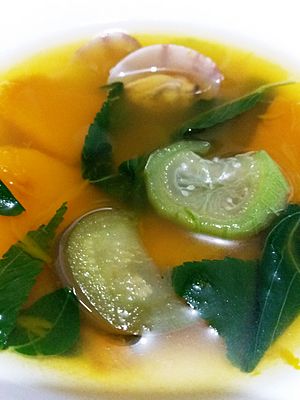Sinabawang gulay facts for kids
 |
|
| Alternative names | Filipino vegetable soup, utan bisaya, sabaw na utan, law-oy, laswa, bulanglang na gulay |
|---|---|
| Type | Soup |
| Place of origin | Philippines |
| Serving temperature | hot |
| Main ingredients | various leafy vegetables |
Sinabawang gulay is a tasty Filipino vegetable soup. It is also known as Filipino vegetable soup. This soup is made with different kinds of leafy greens and other vegetables. They are cooked in a broth that gets its flavor from seafood stock or patis (which is a type of fish sauce). The exact ingredients can change a lot, depending on who is making it. People often eat this soup by itself or with white rice.
Different Names for This Soup
The name "Sinabawang gulay" simply means "vegetable soup." This dish is popular all over the Philippines. Because of this, it has many different names!
- In Batangas, it is called bulanglang na gulay.
- In the Visayas and Mindanao regions, you might hear it called sabaw na utan, law-oy, utan bisaya, or utan kamunggay.
- In Western Visayas, it is known as laswa.
There is also a dish called Dinengdeng from Northern Luzon. It is a type of sinabawang gulay, but it does not use garlic.
What is in Sinabawang Gulay?
The main ingredients in Sinabawang gulay are leafy vegetables. Some common ones include moringa leaves, mustard greens, pepper leaves, and pechay.
Many other vegetables are also added to the soup. These can include:
- Okra
- Calabaza (a type of squash)
- Eggplant
- Yardlong beans
- Bitter melon
- Calabash
- Chayote
- Green papaya
- Taro tubers
The soup's broth is made with onion, tomato, garlic, and ginger. It is seasoned with seafood stock or patis (fish sauce). Sometimes, people also add lemongrass and siling haba (a type of chili pepper) to the broth for extra flavor.
In some parts of the Philippines, people might add dried fish, shrimp, mussels, or clams to their sinabawang gulay.
How is it Different from Other Dishes?
Sinabawang gulay is similar to other Filipino soups like tinola. However, the main difference is that sinabawang gulay does not use any meat.
It is also a bit like vegetable-based ginataan dishes, such as ginataang kalabasa or ginataang ampalaya. But sinabawang gulay does not use coconut milk, which is a key ingredient in ginataan dishes.

